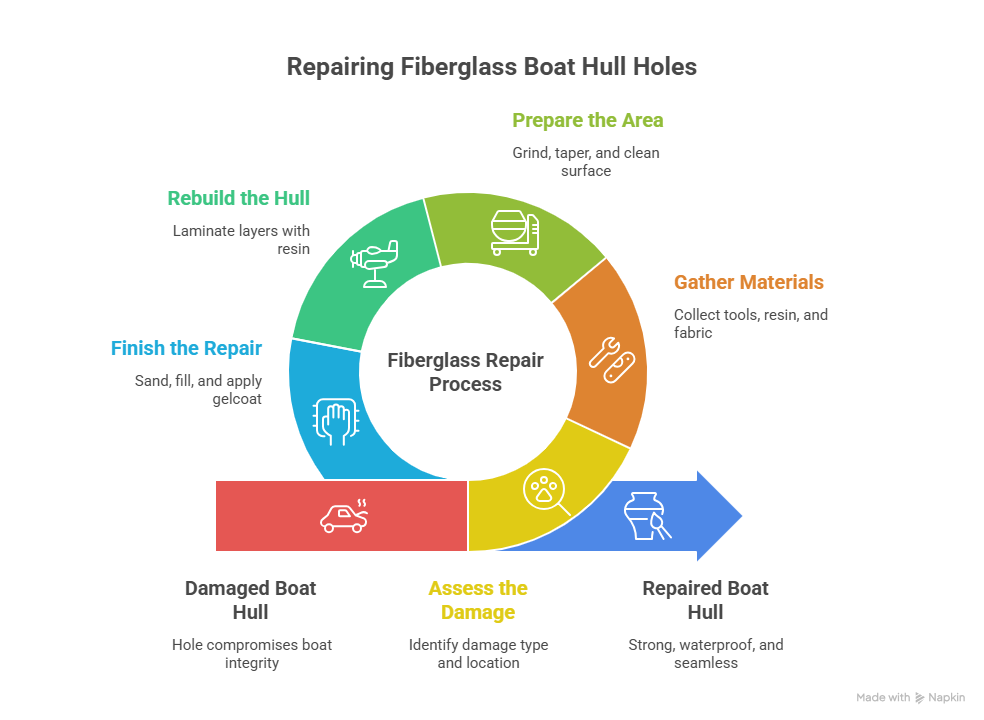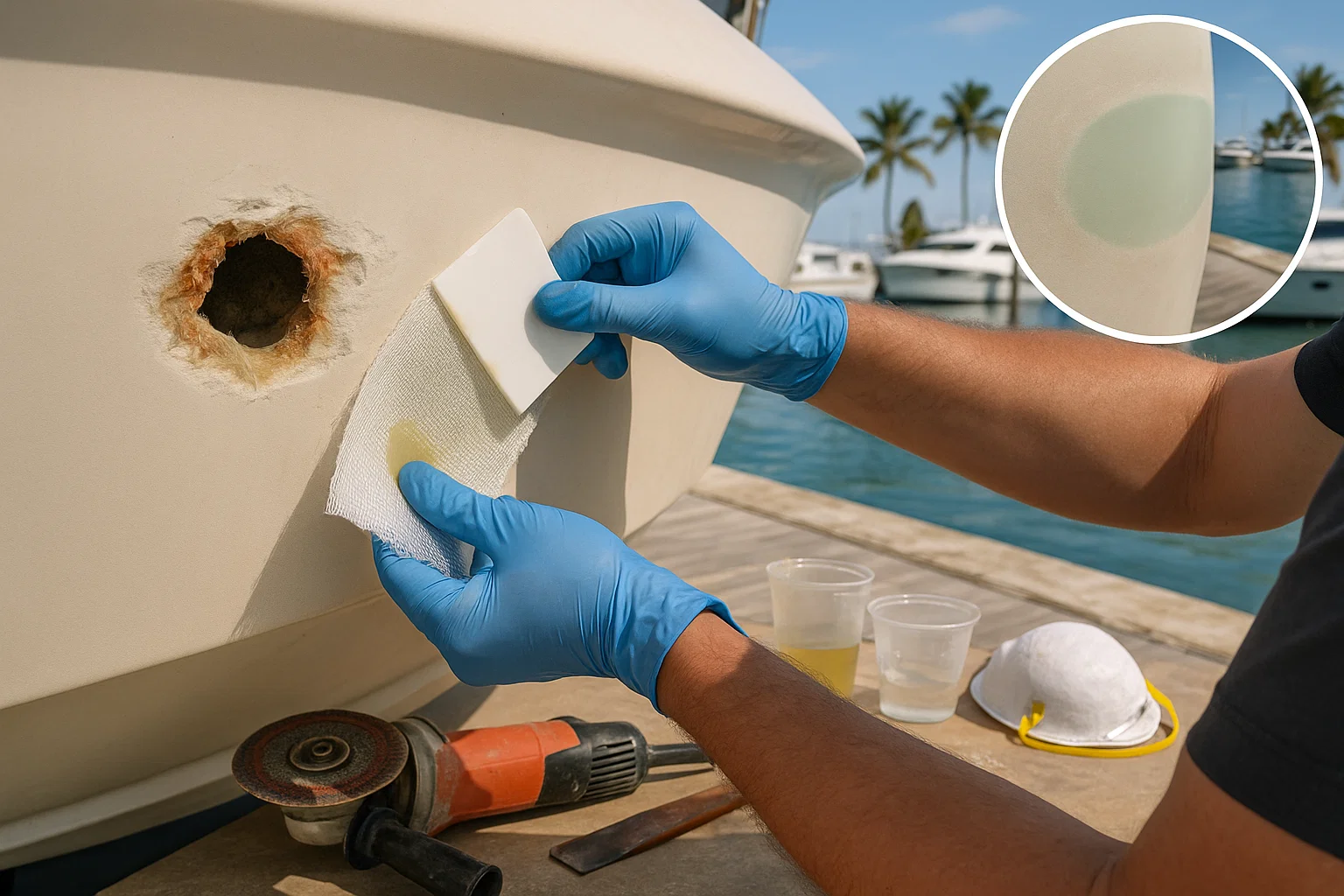I’ve been patching up boats in South Florida for over 15 years, and let me tell you, figuring out how to repair a hole in a fiberglass boat hull is one of those jobs that shows up way too often—especially after a rough day off Stiltsville or a bump at Bahia Mar. It’s intimidating at first, but if you take it step by step, you can turn a scary gash into a solid, invisible fix that holds up in our salty waters. Aluminum boat corrosion repair is one thing, but fiberglass holes? They need a different approach, with proper tapering and layers. I’ll walk you through how to repair a hole in a fiberglass boat hull like I’d explain it to a buddy at Dinner Key Marina over a quick coffee—complete with the mistakes I’ve seen (and made) along the way. We’re talking assessment, tools, prep, laminating, and finishing, all grounded in real jobs I’ve done.
Table of Contents
Assessing the Damage: Figuring Out What You’re Really Dealing With
Before you even think about mixing resin, you’ve got to get a handle on the damage— that’s the first rule in how to repair a hole in a fiberglass boat hull. I’ve seen owners dive right in without checking, and it bites them later. Last June, a guy named Mike at Bahia Mar brought in his Boston Whaler with what looked like a small ding from a dock scrape. Turned out to be a fist-sized hole below the waterline, with some core rot creeping in—ended up being a $1,200 job after we tapped around and found the soft spots. Drives me nuts when folks ignore that; a quick assessment saves headaches.
Know Your Damage Type
Not every scratch is a crisis, but you need to ID it right for how to repair a hole in a fiberglass boat hull. Surface gouges are just cosmetic—easy gelcoat touch-ups. Crazing, those spiderweb cracks, often mean stress underneath, and I’ve fixed plenty on older Sea Rays where the fiberglass was flexing too much. But structural holes? That’s when you see frayed fibers poking out—those are the ones that can sink you if not handled properly. I always start by poking around with a screwdriver to see how deep it goes.
Location Dictates Urgency
Where the hole is matters a ton in how to repair a hole in a fiberglass boat hull. Below the waterline? That’s urgent—water pours in, and in Miami’s humid marinas, it leads to rot fast. I had a client, Sofia, at Coconut Grove last summer; her hole was just above the line but let in enough spray during a choppy Biscayne Bay run to soak the core—$800 fix that could’ve been half if caught sooner. Above the waterline holes are less panic-inducing, but seal ’em quick to keep moisture out. Yeah, right—I’ve pulled soggy balsa from too many “minor” dings.
Check for a Compromised Core
Most fiberglass boats have a core—wood or foam sandwiched in—and if it’s wet, you’re in for more work on how to repair a hole in a fiberglass boat hull. Do the tap test: grab a screwdriver handle and knock around the area. Sharp ping? Good core. Dull thud? Rot city. I learned this the hard way on a buddy’s Grady-White off Key Biscayne—tapped a soft spot, dug in, and found mush that spread two feet. Had to chisel it all out before patching; saved the hull but added hours.
Taking time here ensures your repair lasts—skip it, and you’re just plugging a symptom.
Gathering Your Arsenal: Tools and Materials I Swear By
You can’t wing how to repair a hole in a fiberglass boat hull without the right stuff; I’ve tried, and it ends in frustration. Assemble everything first—it’s like prepping for a long weekend on the water. Over the years, I’ve built my kit from jobs at Dinner Key, and it’s saved my bacon more than once.
Choosing the Right Resin: Epoxy vs. Polyester
Resin is the backbone, and picking wrong can weaken the whole fix in how to repair a hole in a fiberglass boat hull. Polyester is cheap and what most hulls are made with, but it doesn’t bond great to old fiberglass—fine for small stuff, but not my pick. Epoxy? That’s the gold standard; stronger, more waterproof, especially for structural work. I used it on Ray’s Pursuit last fall after he punched a hole scraping a piling—held like iron through hurricane season.
Selecting Fiberglass Fabric: Mat vs. Cloth
For rebuilding strength, you need fabric layers in how to repair a hole in a fiberglass boat hull. Chopped strand mat builds bulk and curves well—great for the base. Woven cloth adds tensile strength; it’s the muscle. I alternate them for best results. But hey, I put this table together from repairs I’ve done in Miami—shows what I use when, with rough costs from local suppliers like those at Bahia Mar.
| Material | Best For | Average Cost (Per Sq Ft) | My Notes from Real Jobs |
|---|---|---|---|
| Epoxy Resin | Structural bonds, waterproofing | $10–$15 | Go-to for below-waterline; mixed wrong once and had to redo a whole patch—lesson learned. |
| Polyester Resin | Quick cosmetic fixes | $5–$8 | Cheaper but weaker—used it on a non-structural ding, failed in salt after a year. |
| Chopped Strand Mat | Building thickness, curves | $2–$4 | Conforms easy; soaked it wrong on a curved hull and got bubbles—always stipple now. |
| Woven Cloth | Strength and stiffness | $3–$6 | Layers well; reinforced a transom hole that held through rough Biscayne waves. |
Your Non-Negotiable Tools & Safety Gear
No full shop needed, but essentials make or break how to repair a hole in a fiberglass boat hull. Angle grinder with 36-grit discs for tapering, random orbit sander for fairing, mixing cups, brushes. Safety first—respirator for fumes (fiberglass dust is nasty), nitrile gloves, goggles. I skipped the respirator once grinding at Key Biscayne—coughed for days. Not worth it.
The Critical Preparation Phase: Grinding and Tapering Like a Pro
Prep is 80% of how to repair a hole in a fiberglass boat hull—if you rush, it fails. I’ve seen patches pop off because someone skimped here. Take Carlos’s Sea Ray; he tried a quick fill, came back leaking worse. We ground it proper, and it’s held two years.
Step 1: Cut and Grind Away All Damaged Material
Remove all junk first in how to repair a hole in a fiberglass boat hull. Grinder or rotary tool to excise cracked bits—make the hole bigger if needed for solid edges. Better overdo it than leave weak spots.
Step 2: Create a Tapered “Scarf” Joint
This is key for strength: bevel the edges with the 12:1 rule—for 1/4-inch hull, 3-inch taper. Grind a shallow dish; it bonds massive area. I botched this early on a Jon boat—patch delaminated in a month. Now I measure twice.
Step 3: A Final, Thorough Cleaning
Acetone wipe-down, two-rag method—clean rag follows the dirty one. No fingerprints after. Sets up a perfect bond.

Rebuilding the Hull: Laminating Step by Step
Now the rebuild in how to repair a hole in a fiberglass boat hull—layer by layer, like stacking pancakes but with resin.
Step 1: Create a Backing Support (If Needed)
For through-holes, tape a waxed cardboard backer—matches the curve, supports wet layers.
Step 2: Cut and Stage Your Fiberglass Layers
Cut pieces smallest to largest before mixing—resin’s pot life is short. Stack ’em ready.
Step 3: Mixing and Applying Resin
Measure exact, stir two minutes. Prime the area with a thin coat.
Step 4: Building Up the Laminate Layers
Lay fabric, saturate to translucent, squeegee bubbles center-out. Build proud for sanding. Javier’s hole off Stiltsville? Layered it this way—$600 fix, still solid.
Finishing Strong: Sanding to Invisible
Structural done? Now fair how to repair a hole in a fiberglass boat hull to blend in.
Step 1: Curing, Filling, and Fairing
Cure 24 hours, sand high spots, skim marine filler, block-sand smooth.
Step 2: Applying the Gelcoat Finish
Acetone clean, mask, mix with catalyst, brush thin coats.
Step 3: Wet Sanding for a Professional Shine
Wet-sand 400-1500 grit, compound, polish, wax. Turns rough into showroom.
FAQ – Questions I Get All the Time at the Marina
Folks hit me up with these while I’m working—straight answers from experience.
How long does it take to repair a hole in a fiberglass boat hull?
A small one? Weekend. Big structural? Week, with cure times. Rushed Mike’s once—had to redo.
Can I use polyester for how to repair a hole in a fiberglass boat hull below waterline?
Nah, epoxy’s safer. Polyester failed on a client’s boat in salt—leaked fast.
What’s the biggest mistake in how to repair a hole in a fiberglass boat hull?
Poor tapering. Skimpy bevel means weak bond—seen it pop on choppy days.
Do I need pro help for how to repair a hole in a fiberglass boat hull?
DIY for small, but core rot or big holes? Call in—saved a guy’s insurance claim that way.
How do I know if my repair held in how to repair a hole in a fiberglass boat hull?
Pressure test or float it—I’ve tapped and hosed patches to check.
Is epoxy always better for how to repair a hole in a fiberglass boat hull?
Yeah, for strength. Used it on 100+ jobs—rarely callbacks.
Wrapping It Up
How to repair a hole in a fiberglass boat hull isn’t rocket science—it’s methodical work. Assess deep, prep right, layer solid, finish smooth. I’ve botched a few early on, like skipping full cure and having gelcoat crack, but now it’s routine. Do it proper: taper wide, use epoxy, squeegee bubbles, sand patient. Your boat’ll handle Miami waves no problem.
Author Bio
I’m Alex, a 15-year marine technician in South Florida, ABYC-certified, with 200+ fiberglass hull repairs under my belt. From patching small dings on Boston Whalers to full structural rebuilds on Sea Rays with core rot, I’ve handled holes from dock scrapes and impacts at marinas like Dinner Key and Bahia Mar, ensuring boats stay watertight in our humid, salty environment.


Leave a Reply